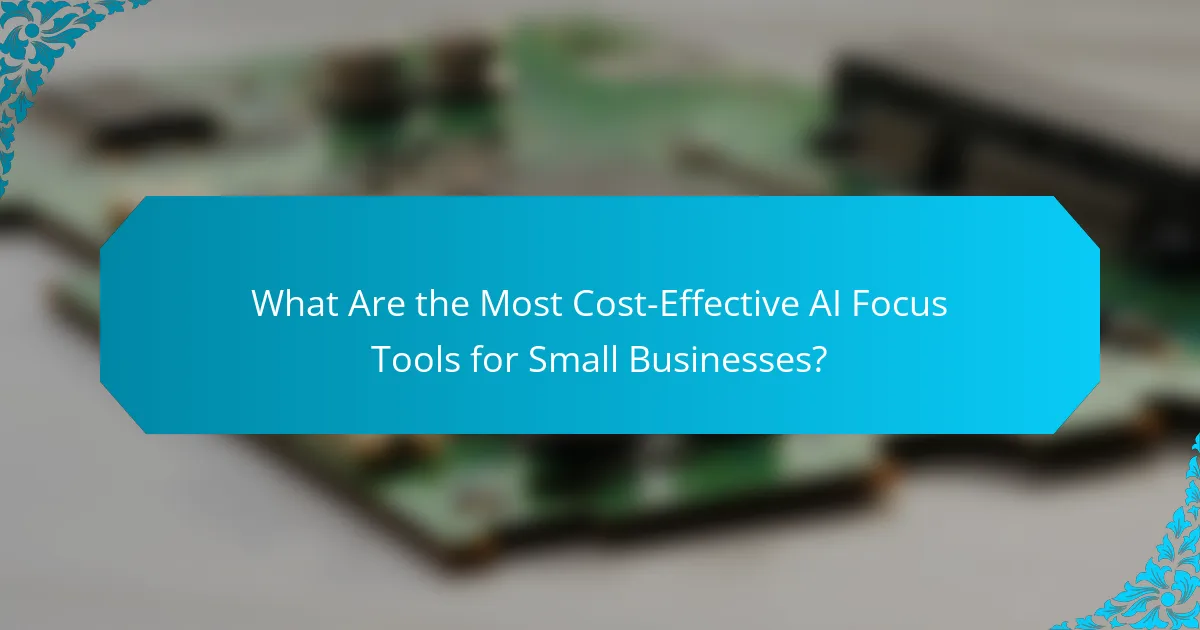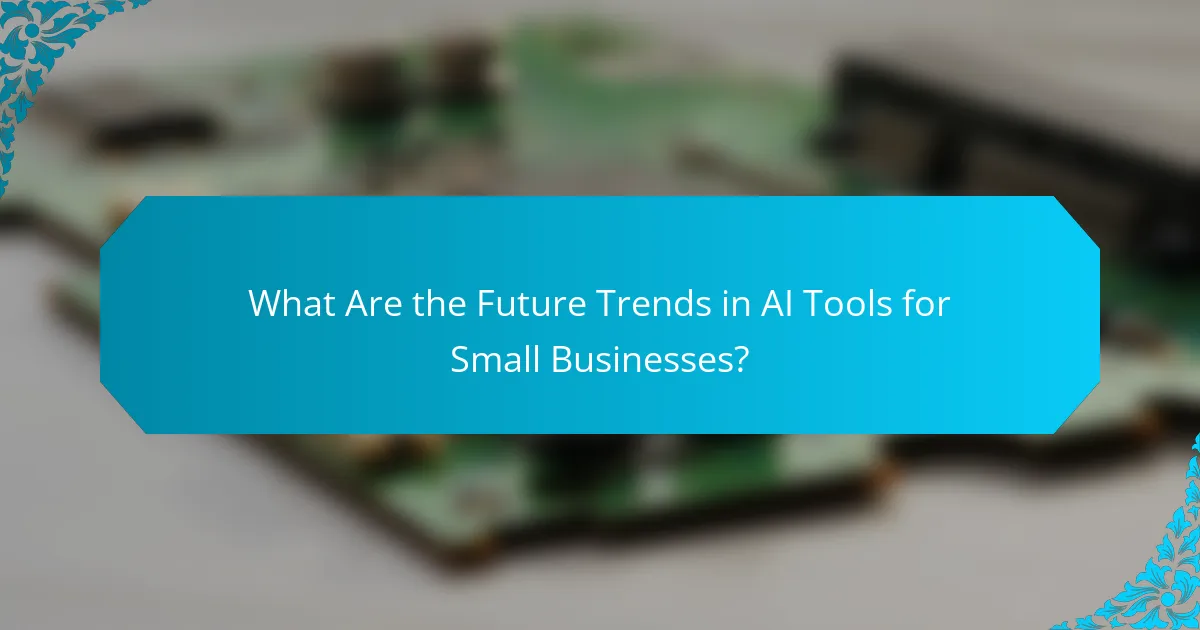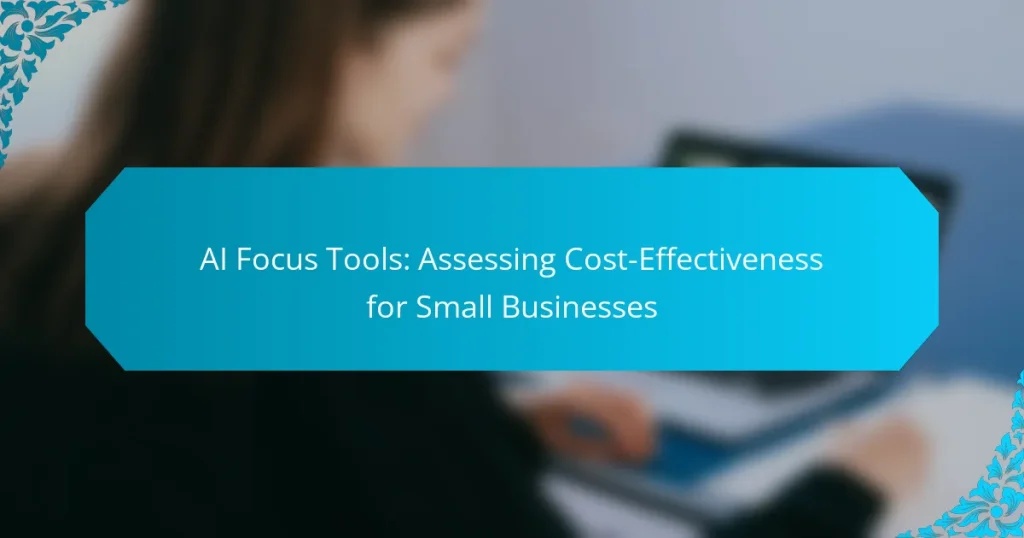Cost-effective AI focus tools can significantly enhance productivity and decision-making for small businesses. By leveraging affordable technology, these tools streamline operations, improve customer engagement, and optimize resource allocation, ultimately leading to better efficiency and informed decision-making.

What Are the Most Cost-Effective AI Focus Tools for Small Businesses?
Cost-effective AI focus tools can significantly enhance productivity and decision-making for small businesses. By leveraging affordable technology, these tools help streamline operations, improve customer engagement, and optimize resource allocation.
Tool A: Description and Pricing
Tool A is an AI-driven project management software designed to help small businesses organize tasks and collaborate effectively. It features automated scheduling, progress tracking, and team communication tools. Pricing typically ranges from $10 to $30 per user per month, depending on the features selected.
This tool is particularly beneficial for teams that require real-time updates and seamless integration with other applications. Many users find that the investment pays off through improved efficiency and reduced project delays.
Tool B: Description and Pricing
Tool B is an AI customer relationship management (CRM) system that focuses on automating customer interactions and data analysis. It offers features like lead scoring, personalized marketing campaigns, and customer support automation. Pricing generally falls between $15 and $50 per user per month.
This CRM tool is ideal for small businesses looking to enhance customer engagement while minimizing manual tasks. The return on investment can be substantial as it helps in converting leads into loyal customers more effectively.
Tool C: Description and Pricing
Tool C is an AI analytics platform that assists small businesses in making data-driven decisions. It provides insights into sales trends, customer behavior, and operational efficiency. The pricing model typically starts at around $20 per month for basic features, with advanced options available for higher tiers.
Comparison of Features
| Tool | Main Features | Price Range (per user/month) |
|---|---|---|
| Tool A | Project management, task automation, team collaboration | $10 – $30 |
| Tool B | Lead scoring, marketing automation, customer support | $15 – $50 |
| Tool C | Data analytics, sales insights, operational efficiency | $20+ |
ROI Analysis
Calculating the return on investment (ROI) for these AI focus tools involves assessing the time saved and increased revenue generated. For instance, if Tool A reduces project completion time by 20%, this can lead to faster delivery and higher client satisfaction, ultimately boosting sales.
Similarly, Tool B’s automation of customer interactions can lead to increased conversion rates, while Tool C’s analytics can help identify profitable market segments. Small businesses should track these metrics to evaluate the effectiveness of each tool and make informed decisions about future investments.

How Do AI Focus Tools Improve Business Efficiency?
AI focus tools enhance business efficiency by automating tasks, providing insights from data, and improving customer interactions. These tools streamline operations, allowing small businesses to allocate resources more effectively and make informed decisions quickly.
Automation of Repetitive Tasks
AI focus tools automate repetitive tasks such as data entry, scheduling, and inventory management. By handling these mundane activities, businesses can free up employee time for more strategic work, increasing overall productivity.
For instance, tools like chatbots can manage customer inquiries 24/7, reducing the workload on staff. Small businesses can expect to save several hours a week, translating to lower operational costs and improved service delivery.
Data-Driven Decision Making
AI tools analyze large volumes of data to provide actionable insights, enabling data-driven decision making. By leveraging algorithms, businesses can identify trends, forecast sales, and optimize pricing strategies.
For example, a small retail business can use AI analytics to determine which products are underperforming and adjust inventory accordingly. This approach can lead to a significant increase in sales and a more efficient allocation of resources.
Enhanced Customer Engagement
AI focus tools improve customer engagement by personalizing interactions and providing timely responses. These tools can analyze customer behavior and preferences, allowing businesses to tailor their marketing efforts effectively.
For instance, email marketing platforms powered by AI can segment audiences and send personalized offers, resulting in higher conversion rates. Small businesses that implement these strategies often see an increase in customer loyalty and satisfaction.

What Factors Should Small Businesses Consider When Choosing AI Tools?
Small businesses should evaluate several key factors when selecting AI tools, including budget constraints, scalability, and integration with existing systems. These considerations help ensure that the chosen solutions align with business goals and operational capabilities.
Budget Constraints
Budget constraints are crucial when selecting AI tools, as small businesses often operate with limited financial resources. It’s essential to assess not only the initial purchase price but also ongoing costs such as subscriptions, maintenance, and potential training expenses.
Consider setting a budget range that accommodates both immediate needs and future growth. Many AI solutions offer tiered pricing models, allowing businesses to start small and expand as their needs evolve. Aim for tools that provide a clear return on investment (ROI) to justify the expenditure.
Scalability of Solutions
Scalability refers to the ability of AI tools to grow with your business. Small businesses should choose solutions that can adapt to increasing workloads or expanding functionalities without requiring a complete overhaul.
Look for tools that offer modular features or flexible pricing plans that can accommodate growth. For instance, a customer relationship management (CRM) system that allows for additional user licenses or advanced features as your customer base grows can be a wise investment.
Integration with Existing Systems
Integration with existing systems is vital for ensuring a smooth workflow. AI tools should seamlessly connect with current software and processes to minimize disruption and maximize efficiency.
Evaluate how well potential AI solutions integrate with your existing tools, such as accounting software or project management platforms. Prioritize tools that offer APIs or built-in connectors to facilitate easy data exchange, which can save time and reduce errors.

What Are the Common Challenges in Implementing AI Focus Tools?
Implementing AI focus tools can be challenging for small businesses due to various factors, including the need for technical expertise, concerns about data privacy, and issues related to change management. Addressing these challenges is crucial for successful integration and maximizing the benefits of AI technologies.
Technical Expertise Requirements
Small businesses often lack the in-house technical expertise required to implement AI focus tools effectively. This can lead to difficulties in selecting the right tools, integrating them with existing systems, and maintaining them over time. Hiring external consultants or investing in training can help bridge this gap, but it may also increase costs.
Consider partnering with local tech firms or universities that offer AI-related programs. This collaboration can provide access to skilled professionals and reduce the learning curve associated with new technologies.
Data Privacy Concerns
Data privacy is a significant concern when implementing AI tools, particularly as regulations such as GDPR in Europe impose strict guidelines on data handling. Small businesses must ensure that they comply with these regulations to avoid hefty fines and reputational damage.
To mitigate risks, businesses should conduct thorough assessments of their data practices and implement robust security measures. Regular audits and employee training on data privacy can further enhance compliance and build customer trust.
Change Management Issues
Change management is often overlooked but is critical when adopting AI focus tools. Employees may resist new technologies due to fear of job displacement or a lack of understanding of how these tools can enhance their work. Effective communication and involvement in the implementation process can alleviate these concerns.
Establishing a clear change management strategy that includes training sessions, feedback mechanisms, and gradual rollouts can help ease the transition. Engaging employees early in the process fosters a culture of innovation and acceptance, leading to smoother implementation.

How to Measure the Success of AI Focus Tools?
Measuring the success of AI focus tools involves evaluating their impact on business objectives, efficiency, and customer satisfaction. Key metrics include performance indicators, customer feedback, and cost savings, which together provide a comprehensive view of the tools’ effectiveness.
Key Performance Indicators (KPIs)
Key Performance Indicators (KPIs) are essential for assessing the effectiveness of AI focus tools. Common KPIs include productivity rates, error reduction percentages, and time savings. For example, a small business might track the decrease in time spent on repetitive tasks, aiming for a reduction of 20-30% within the first few months of implementation.
When selecting KPIs, ensure they align with your specific business goals. Focus on metrics that reflect both operational efficiency and customer outcomes, such as increased sales or improved service response times. Regularly review these indicators to adjust strategies as needed.
Customer Feedback and Satisfaction
Customer feedback is a crucial component in measuring the success of AI focus tools. Gathering insights through surveys, reviews, and direct communication helps assess how these tools enhance the customer experience. Aim for a satisfaction score of 80% or higher to indicate positive reception.
Utilize tools like Net Promoter Score (NPS) or Customer Satisfaction Score (CSAT) to quantify feedback. Analyze trends over time to identify areas for improvement. Engaging with customers regularly can also foster loyalty and provide valuable insights for further enhancements.
Cost Savings Analysis
Cost savings analysis helps determine the financial impact of AI focus tools on small businesses. Start by calculating the initial investment and ongoing operational costs, then compare these with the savings generated from increased efficiency and reduced labor costs. Many businesses aim for a return on investment (ROI) of at least 150% within the first year.
Consider both direct savings, such as reduced staffing needs, and indirect benefits, like improved customer retention rates. Regularly update your analysis to reflect changes in operational costs and market conditions, ensuring that the tools remain a cost-effective solution over time.

What Are the Future Trends in AI Tools for Small Businesses?
Future trends in AI tools for small businesses focus on increased automation, enhanced data analytics, and improved customer engagement. These advancements aim to streamline operations, reduce costs, and provide personalized experiences, making AI more accessible and beneficial for smaller enterprises.
Increased Automation
Automation is becoming a cornerstone for small businesses looking to enhance efficiency. Tools that automate routine tasks, such as scheduling, invoicing, and customer support, allow businesses to allocate resources more effectively. For instance, chatbots can handle basic customer inquiries, freeing up staff for more complex issues.
When considering automation tools, small businesses should evaluate their specific needs and the potential return on investment. Many platforms offer tiered pricing, allowing businesses to start small and scale as needed. Common pitfalls include over-automation, which can lead to a loss of personal touch in customer interactions.
Enhanced Data Analytics
AI-driven data analytics tools are increasingly important for small businesses to make informed decisions. These tools can analyze customer behavior, sales trends, and market conditions to provide actionable insights. For example, a small retail shop might use analytics to determine peak shopping times and optimize staffing accordingly.
Small businesses should look for user-friendly analytics platforms that integrate with existing systems. Many tools offer free trials, allowing businesses to test functionality before committing. It’s crucial to avoid data overload; focus on key performance indicators that directly impact business goals.
Improved Customer Engagement
AI tools are transforming how small businesses engage with customers, leading to more personalized experiences. Solutions like recommendation engines and targeted marketing campaigns can significantly enhance customer satisfaction and loyalty. For instance, an online store might use AI to suggest products based on previous purchases.
To effectively implement customer engagement tools, small businesses should prioritize understanding their audience. Investing in training for staff on these tools can maximize their potential. Additionally, businesses should monitor engagement metrics to assess the effectiveness of their strategies and adjust as necessary.


